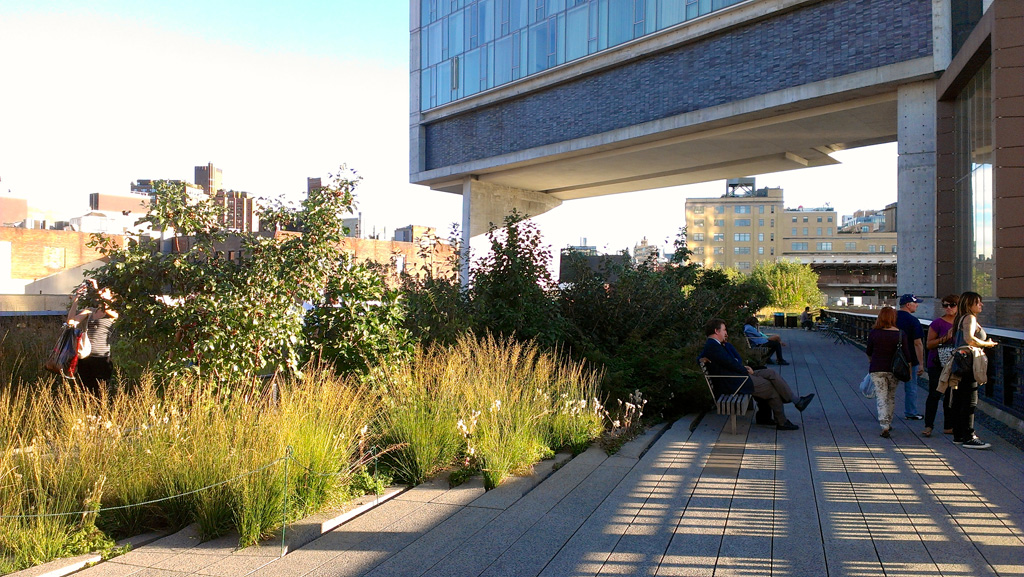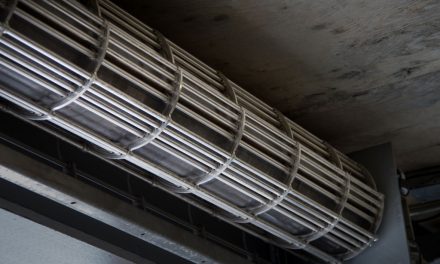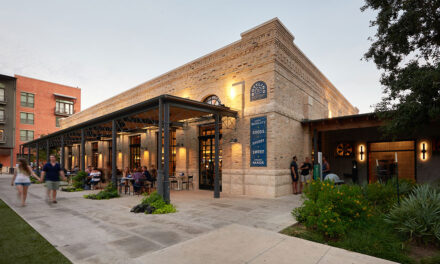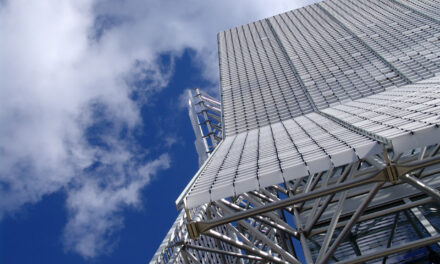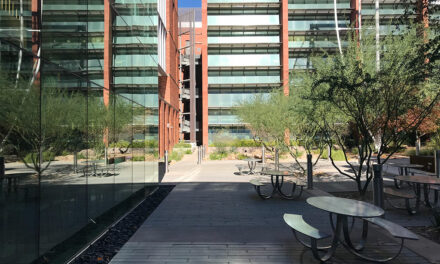In today’s society, sectors across industry are reaping the economic benefits of biophilic design. By examining five of these sectors—workplaces, healthcare, retail stores, schools, and communities—we can begin to understand the fiscal implications of biophilic design across the economy. The numbers and percentages presented reflect powerful evidence that design and planning strategies informed by nature can lead to positive impacts on human health, child development, community safety, and worker satisfaction. These effects translate directly to increased profits.
Healthier Patients, Healthier Profits – Biophilic Design in Hospitals
Spending in the United States’ healthcare sector is at record levels and growing. In 2016, the U.S. spent $3.3 trillion on healthcare (U.S. Department of Health and Human Services (HSS), 2016) and that number is expected to rise to $5.7 trillion by 2026 (U.S. HSS , 2016a). Reducing these costs without sacrificing health outcomes is critical for the economic stability of the hospital system and its users. Biophilic design strategies can contribute to improved outcomes as an evidence-based solution.The process of evidence-based design for healthcare settings combines the best information from other fields, in this case current healthcare design research and the physiological and psychological needs of patients, doctors, and staff (Hamilton & Watkins, 2009).
Current research suggests that one of these needs is exposure to nature and natural systems, and that incorporating even small elements of biophilic design into the healthcare settings can improve patient outcomes, reduce the need for pain medication, reduce stress, and improve the working environment for those caring for patients. In 2017, the U.S. spent over $41 billion on healthcare construction (U.S. Department of Commerce, 2017). The contribution of biophilic design to improved outcomes are paired with financial savings. Over fifty published studies associate biophilic elements, such as healing gardens and controlled access to daylight, as primary influences for improved outcomes, which translate to cost savings.
Healthcare design can contribute to alleviating stress in both patients and care providers, which in turn can affect patient outcomes. Patients may already be stressed, be it from acute or chronic trauma, recovery, or the anticipation of test results; they are therefore more susceptible to stress, which can affect the body psychologically, physiologically, biochemically, and behaviorally (Ulrich, 1999). A stressed body heals more slowly, is less resistant to infection, and may have heightened emotional reactions. Common sources of stress caused by the physical environment in hospitals include noise, poor control of lighting conditions, and confinement in a completely artificial environment (Ulrich et al., 2006). While a healthcare facility itself does not directly affect treatment or recovery, it can be designed in a way that does not add to patient stress, and may possibly provide a source of distraction from pain or boredom.
Patient Health and Medical Expenses
In 1984, Roger Ulrich conducted what would become a seminal study, measuring the influence of a view of natural scenery on patients recovering from gallbladder surgery. Some patient rooms had views of a natural scene while others faced a brick wall. After accounting for other variables, his findings showed that patients who did not have a view of a brick wall had shorter postoperative hospital stays, a lower consumption of pain medications, and fewer negative evaluative comments from nurses. On average, the patients whose windows overlooked a scene of nature were released after 7.96 days, while patients with the view of the wall stayed 8.71 days —a decrease of 8.5% (Ulrich, 1984). In economic terms this is a significant cost reduction to the patient and the hospital at large. According to the Agency for Healthcare Research and Quality, the average expenditure per diem for a hospital stay after surgery in 2010 was $4,221 (Mirel & Carper, 2013). Applied to Ulrich’s study, the cost of patient care could have been reduced by over $145,000 if all 46 patients were released at the earlier time. While this is not an a precise calculation of cost savings, it may indicate the potential magnitude of savings that biophilic design elements in a hospital might contribute.
These seemingly small improvements in patient outcomes can still result in sizeable savings when spread across the 5,795 registered hospitals in the U.S. (American Hospital Association, 2018). In 2015, 51,430 major operational procedures took place in the United States, with resulting in hospital stays that averaged 4.8 days (U.S. HSS, 2010). Applying the same decrease in stay from Ulrich’s study, we estimate that the average length in hospital stay will decrease by roughly half a day (.41 days). Given that the national average expense per diem of a hospital stay after surgery is $4,221, and that the number of surgeries in the United States has remained relatively stable since 2010, we estimate that the nationwide savings per year due to reduced hospital stay associated with major surgery to be about $89 million (see Appendix). Again, the purpose of this calculation is not to pinpoint an exact industry cost savings, but rather to generate an idea of what the economic impacts of biophilic design are on the healthcare industry.
Subsequent studies built upon Ulrich’s findings (Kellert, 2008). Examples from mental health research include a 1996 study conducted by Beauchemin and Hays (1996) who found a 2.6 day decrease in length of stay for bipolar disorder and depression patients in sunny, daylit rooms, when compared with those in dimmer rooms with only artificial lighting. A similar study conducted in 2001 found the mean stay was 3.67 days shorter for patients with bipolar disorder in rooms with direct morning sunlight when compared with those who had none (Benedetti et al., 2001). Pharmaeconomists at the University of Texas Health Science Center in Houston estimated that each case of treated bipolar disorder costs a minimum of $11,720 (Begley et al., 1998). If one applies this number to the context of the work of Benedetti et al., and if a fraction of this value was deducted because of reduced treatment time, $271,904 could have potentially been avoided had the other 87 patients in this study also been released earlier as a result of recovering in naturally lit rooms.
Another example of the built environment’s effects on patient outcomes is the inclusion of daylight and windows for patients. These are important for two reasons: daylight for health, and views for relieving stress. First, access to daylight, and conversely, darkness, can affect patient mood and sleeping habits. Second, patient and recovery rooms that have views of nature may help reduce patient recovery times. Everyone, not just those suffering from health issues, benefits from exposure to natural daylight cycles, which help set circadian rhythm. Evidence shows there are benefits for exposing even newborns to sunlight (Barss and Comfort, 1985; Giunta and Rath, 1969). Both staff and patients who spend hours and days inside the hospital risk low vitamin D and disrupted sleep without exposure to daylight. The benefits of providing windows to patients undergoing treatment or recovering have already been described. By providing a distraction, a view of nature may also reduce perceived pain levels (Ulrich, 1999). Distraction theory, taking a cue from gate control theory (Melzack and Wall, 1985, 1982), posits that positive views (e.g., of nature) can help lessen the perception of pain by diverting attention away from the source (Brewer and Karoly, 1989). Views, like artwork and other visual distractions, should be interesting as well as safe and non-threatening (Kellert, 2008). Previous studies shows that views of shadowy forests or art that is “abstract, emotionally negative, or surreal” had either no effect, or actually increased stress for those already in stressful positions (Ulrich, 1999; Ulrich et al., 2006).
In 2005, a study assessed the significance of sunlight in a hospital room on patients’ recovery from a cholecystectomy by measuring the quantity of analgesic medication and resulting costs. The patients were divided into rooms with varying sunlight. Patients in more brightly lit rooms experienced 46% higher-intensity sunlight on average than those in dimmer rooms. The study determined that patients exposed to greater levels of sunlight perceived less pain, took 22% less analgesic medications per hour, and accrued 21% less in pain medication costs for the length of their stay (Walch et al., 2005).
Healing Gardens
A growing body of evidence shows patients and visitors benefit greatly from access to healing gardens. Including gardens in a healthcare facility for the benefit of both patients and staff is not a new idea, but often seems at odds with building closed-off and sterile places to house modern technology (Ulrich, 1999, 2002). While the benefits of gardens have long been considered best practice, and the theory behind their potential benefits strongly supported, researchers and designers have recently begun to examine these benefits with more rigor. Results from evidence-based design research have been so compelling that Dr. Naomi Sachs of the Therapeutic Landscapes Resource Center estimates that between 280-570 hospitals in America have incorporated large-scale healing gardens on into their grounds design layout in order to provide patients with a sense of control, physical movement, and access to nature as a positive distraction (Domke, 2008). Evidence-based research supporting effective healing gardens is not about the creation of strict design rules, but rather the use of quality research to offer either a range of possible design responses to user needs or the establishment of environmental performance standards (Marcus, 2016). The benefits of nature in the hospital setting extend to family members and visitors. In a survey of four independent hospitals, 95% of hospital visitors who spent time in the hospitals’ gardens reported feeling more relaxed and calm after the visit. They also reported feeling less stressed and more able to cope with the situation (Marcus & Barnes, 1995). For caregivers, having a access to a lush, green, outdoor area may make their already precious down time more restorative, something that benefits them and their patients.
Increases in stress in both patients and nursing staff arise when there is high responsibility and low control (i.e., the responsibility of recovering or the responsibility of patient well-being, and the inability to alter one’s surroundings or take a restorative break). Studies in horticulture therapy and healing gardens for patients have directly credited these activities with reducing patient and staff stress, reducing patient medication use, and increasing staff satisfaction (Sadler et al., 2008). There are many factors that influence and trigger stress, but the built environment can act as a stress reliever for outside stresses, as well as independently trigger positive physiological reactions. A biophilic built environment can provide positive distractions. Positive distractions also promote well-being by evoking positive feelings that hold attention away from negative thoughts. Other interventions include the presence of natural elements such as water, plants, trees, and non-threatening animals. While not as impactful as dynamic types of nature, scenes of nature in artwork and murals have been shown to reduce anxiety and discomfort.
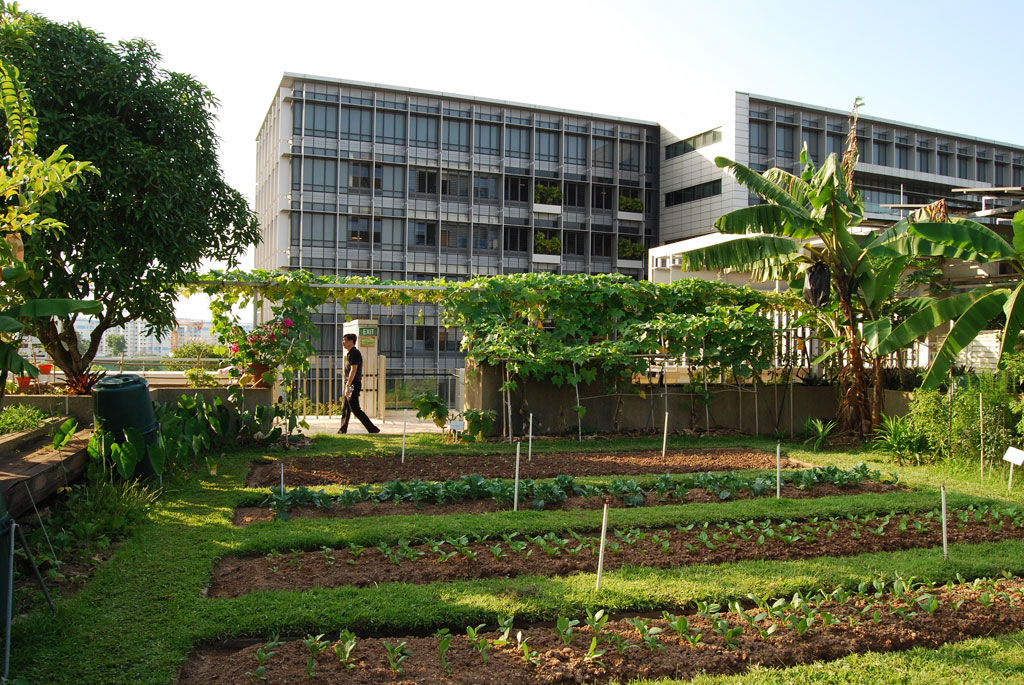
“Healthful effects of gardens … may arise not only directly from exposure to nature, but also indirectly through the enhanced access to other important stress reducing resources or activities [such as exercise and social interaction] that a well-designed garden provides” (Ulrich, 1999).
Khoo Teck Puat Hospital. Credit: Bill Browning
Staff Productivity and Wellbeing
The benefits from exposure to nature extend not only to patients and visitors, but to hospital staff as well, whose alertness is crucial to the comfort and health of patients. According to a recent study, nurses who rate themselves as being in suboptimal health are more likely to make medical errors (Melnyk et al., 2018). In the study, which surveyed 1,790 U.S. nurses, 54% reported being in suboptimal physical and mental health, and about half had made at least one medical error in the past five years. The study concluded that nurses in poor health had a 26-71% greater likelihood of reporting medical errors than healthier staff. As the lead author points out, nurses and other healthcare providers are known for taking care of others, but often at their own expense.
Nurses and hospital staff feel the effects of anxiety, depression, and lower job satisfaction when they have limited access to views to nature or contact with the outdoors. Conversely, staff members recover from stress more easily and perform better when provided with access to gardens and sunlight.
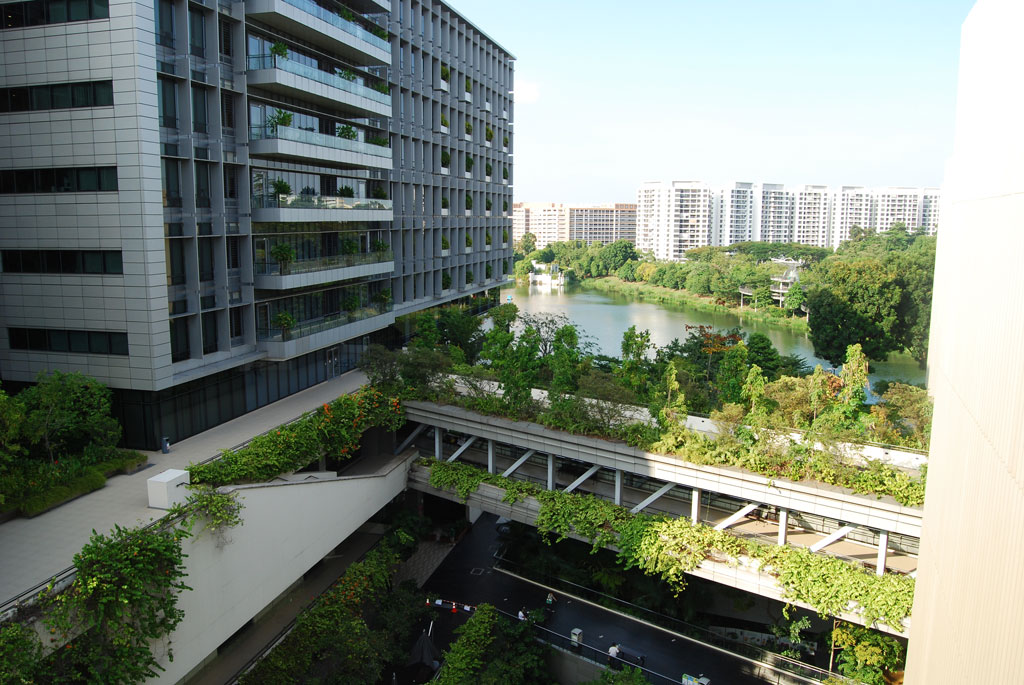
Khoo Teck Puat Hospital. Credit: Bill Browning
From Theory to Practice
Khoo Teck Puat Hospital (KTPH) in Singapore incorporates many biophilic design patterns to create a healing environment for patients, visitors, and staff. The hospital’s orientation takes advantage of the prevailing breeze to allow for as much natural ventilation as possible, and the site has a green plot ratio of 3.92. Lush, native greenery reaches from the central courtyard and is integrated into upper balconies, making the hospital feel like an extension of the natural landscape.
In 2016, a post-occupancy survey was conducted with a sample group of 200 users comprising of patients, staff and visitor at both KTPH and an older hospital designed according to earlier approaches for healthcare design. The survey focused on the effects of water and greenery on user perceptions and feelings of well-being. The survey responses showed that biophilic design elements could be attributed to KTPH performing better than its counterpart when comparing perceived beauty, self-reported well-being, and user awareness of and proximity to nature. Out of six such constructs, four corresponded with biophilic design.
A pioneering pre- and post-occupancy study of patients at Ostra Psychiatry Hospital in Sweden substantiates the connection between physical environment and patient health. A redesign of the hospital included several biophilic design strategies to create a calming, restorative space for patients suffering from mental illness. Coercive medication use, shackle restraint, and readmission after seven days all decreased significantly after moving to the new building. Furthermore, staff sick listing decreased from 9% to 6% following the redesign (From & Kundig, 2010).
Evidence suggests that natural light, access to nature, and views of nature should be incorporated into design for healthcare facilities. While there are initial upfront costs to this design, the growing body of research shows that the payback is quantifiable in patient and staff benefits. Scientific studies continue to support the integration of nature into hospital settings for patient wellness, increased profit margins, and reduced hospital budgets.
“The Economics of Biophilia” is a six-part republication of “The Economics of Biophilic Design” by Terrapin Bright Green. As a series, each section explores one of five economic indicators as it relates to biophilic design: workplace, healthcare, education, retail, and community.
Work References:
American Hospital Association (2018). “Fast Facts on US Hospitals.” Health Forum LLC. Chicago, IL.
• https://www.aha.org/statistics/fast-facts-us-hospitals
American Heart Association. (2017). “Cardiovascular disease: A costly burden for America – Projections through 2035.” American Heart Association. Dallas, TX.
Beauchemin, K.M. & Hays, P. (1996). “Sunny hospital rooms expedite recovery.” Elsevier Science Ltd., Journal of Affective Disorders, 40, 49–51. Alberta, Canada.
• Choi JH, Beltran L and Kim H. Impacts of indoor daylight environments on patient average length of stay (ALOS) in a healthcare facility. Building and Environment 2012; 50: 65-75
Benedetti, F., Colombo, C., Barbini, B., Campori, E., and Smeraldi, E. (2001). “Morning sunlight reduces length of hospitalization in bipolar depression.” Elsevier Science Ltd., Journal of Affective Disorders, 221–223. Milan, Italy.
Begley, C.E., Annegars, J.F., Swann, A.C. , Lewis, A.C., Coan, S., Schnapp, W.B., & Bryant-Comstock, L. (2001). “The lifetime costs of bipolar disorder in the US: an estimate for new cases in 1998.” The University of Texas Health Science Center. Houston, TX. 2001.
Domke, H. (2008). “What’s new with healing gardens?” Healthcare Fine Art. Interview with Naomi Sachs. Web. http://henrydomke.com/blog/2008/05/09/whats-new-with/
From, L., Kundig, S. (2010). “Architecture as Medicine – the Importance of Architecture for Treatment Outcomes in Psychiatry.” ARQ – the Architecture Research Foundation. Uppswala, Sweden.
Hamilton, K., and Watkins, D. (2009). “Evidence-Based Medicine and Healthcare Design, “ Chapter 5 (pages 77-91) in Evidence-Based Design for Multiple Building Types. John Wiley.
Kellert, S.R., Heerwagen, J, and Mador, M. (2008). Biophilic Design: The Theory, Science and Practice of Bringing Buildings to Life. Wiley: New Jersey.
Marcus, C.C. (2016). The Future of Healing Gardens. Heath Environment Research & Design Journal, 9 (2), 172-174.
Marcus, C. C. & Barnes, M. (1995). “Gardens in Healthcare Facilities: Uses, Therapeutic Benefits, and Design Recommendation.” University of California at Berkeley. The Center for Health Design.
Melnyk, B.M., Orsolini, L., Alai, T., Arslanian-Engorer, C., Lekus, G., Dunbar-Jacob, J., Rice, V.H., Millan, A., Dunbar, S.B., Braun, L.T., Wilbur, J., Chyun, D.A., Gawlik, K. & Lewis, L.M. (2018). “A National Study Links Nurses’ Physical and Mental Health to Medical Errors and Perceived Worksite Wellness.” Journal of Occupational and Environmental Medicine, 60(2), 126-31.
Mirel, L.B., and Carper, K. (2013). “Expenses for Hospital Inpatient Stays, 2010. Statistical Brief #401.” Agency for Healthcare Research and Quality, Rockville, Md. https://meps.ahrq.gov/data_files/publications/st401/stat401.shtml
Sadler, B.L., DuBose, J.R., Malone, E.B., & Zimring, C.M. (2008). “Healthcare Leadership: The Business Case for Building Better Hospitals through Evidence Based Design.” Georgia Institute of Technology, The Center for Health Design.
Ulrich, R. S. (1984). “View through a window may influence recovery from surgery” Science, 224(4647), 410-1.
Ulrich, R.S. and Lunden. (1990). “Effects of Nature and Abstract Pictures on Patients Recovering from Open Heart Surgery.” Paper presented at the International Congress of Behavioral Medicine. Uppsala, Sweden.
Ulrich, R. S. (1993). “Biophilia, Biophobia, and Natural Landscapes.” In S. A. Kellert and E.O. Wilson (Eds.), The Biophilia Hypothesis. Washington, DC: Island Press/Shearwater. pp. 74-137.
Ulrich, R. S. (1999). “Effects of Garden on Health Outcomes: Theory and Research.” Chapter in C. Maruc and M. Barnes (Eds.), Healing Gardens. New York, Wiley, 27-86.
Ulrich, R.S. (2002). “Health Benefits of Gardens in Hospitals.” Paper for conference, Plants for People. International Exhibition Floriade.
Ulrich, R.S., Zimring, C., Quan, X., and Joseph, A. (2006). The environment’s impact on stress. In S. Marberry (ed.), Improving healthcare with better building design. Chicago: Health Administration Press, pp. 37-61.
U.S. Department of Health and Human Services. Centers for Medicare and Medicaid Services. National Health Expenditure 2010 Highlights. 2010.
World Health Organization (WHO). (2015). Current health expenditure (CHE) per capita in PPP Data by country. Global Health Observatory Data Repository.
U.S. Department of Health and Human Services (U.S. HSS). (2010). National hospital discharge survey: 2010 tables, number of all-listed procedures for discharges from short-stay hospitals, by procedure category and age: United States. National Center for Health Statistics.
U.S. HSS. (2016). National Health Expenditure 2016 Highlights. Centers for Medicare and Medicaid Services.
U.S. HSS. (2016a). National health expenditure projections 2017-2026. Centers for Medicare and Medicaid Services.
• https://www.cms.gov/Research-Statistics-Data-and-Systems/Statistics-Trends-and-Reports/NationalHealthExpendData/Downloads/ForecastSummary.pdf
U.S. Department of Commerce (2017). “Monthly Construction Spending, December 2017” US Census Bureau News. Washington, D.C.
• https://fred.stlouisfed.org/series/TLHLTHCONS
Walch, J.M., Rabin, B.S., Day, R., Williams, J.N., Choi, K., & Kang, J.D. (2005). “The Effect of Sunlight on Postoperative Analgesic Medication Use.” Psychosomatic Medicine 67, 156-163.

